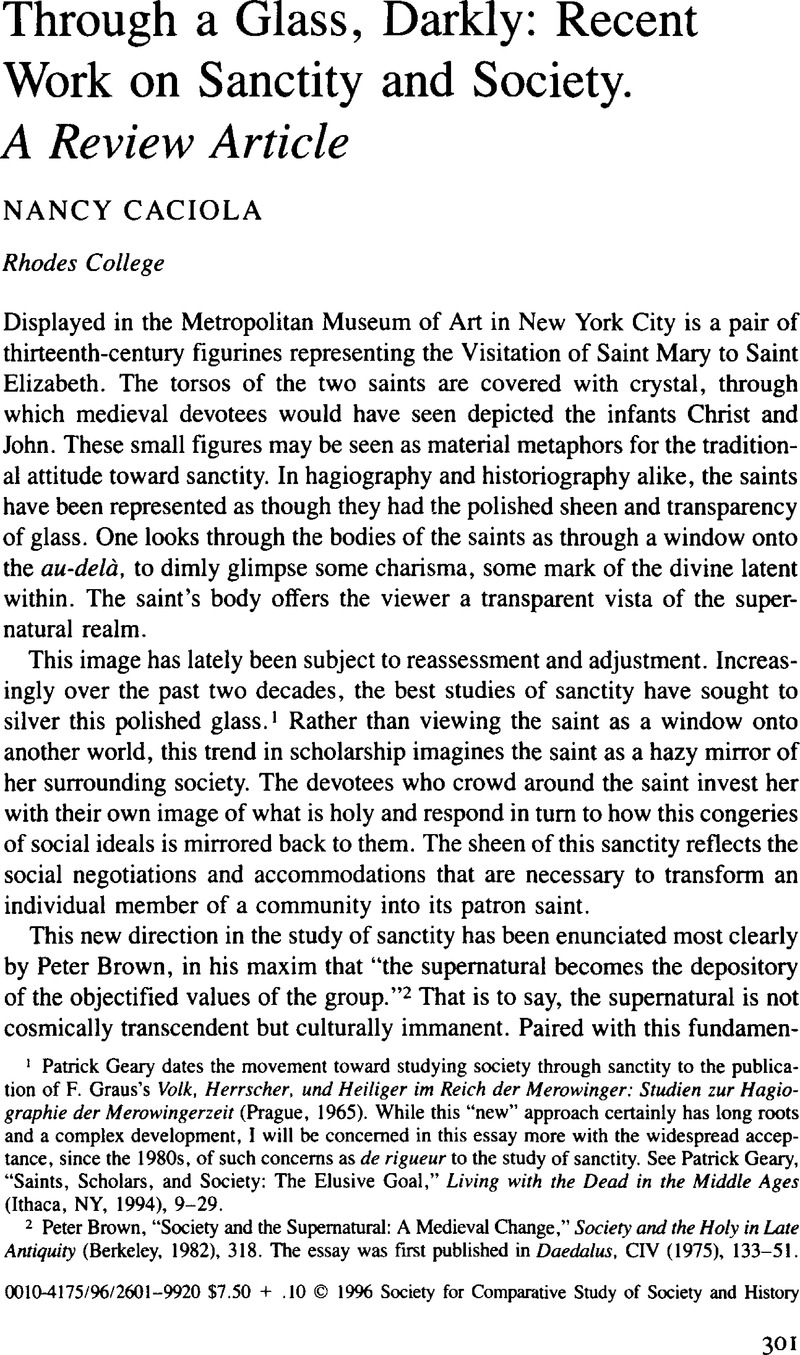Published online by Cambridge University Press: 03 June 2009

1 Patrick Geary dates the movement toward studying society through sanctity to the publication of Graus, F.'s Volk, Herrscher, und Heiliger im Reich der Merowinger: Studien zur Hagiographie der Merowingerzeit (Prague, 1965)Google Scholar. While this “new” approach certainly has long roots and a complex development, I will be concerned in this essay more with the widespread acceptance, since the 1980s, of such concerns as de rigueur to the study of sanctity. See Geary, Patrick, “Saints, Scholars, and Society: The Elusive Goal,” Living with the Dead in the Middle Ages (Ithaca, NY, 1994), 9–29Google Scholar.
2 Brown, Peter, “Society and the Supernatural: A Medieval Change,” Society and the Holy in Late Antiquity (Berkeley, 1982), 318Google Scholar. The essay was first published in Daedalus, CIV (1975), 133–51.
3 Geary, “Saints, Scholars, and Society: The Elusive Goal.” While many of the general developments that Geary charts correspond with my own, I would disagree with his conclusions regarding the future of the field as defined by microstudies. While microstudies are indeed valuable and the specific works he cites admirable, I believe that microstudies work most productively when done in dialogue with broader synthetic studies. Both kinds of work are necessary to provoke further analysis and understanding of the phenomenon of sanctity.
4 See note 2, above; The Cult of the Saints (Chicago, 1981)Google Scholar.
5 Holy Feast, Holy Fast (Berkeley, 1987)Google Scholar; Fragmentation and Redemption (New York, 1990)Google Scholar.
6 La Sainteté en Occident aux Derniers Siècles du Moyen Âge, d'Après les Procès de Canonisation et les Documents Hagiographiques (Rome, 1981)Google Scholar; Les Laïcs au Moyen Âge. Pratiques et Expériences Religieuses (Paris, 1987)Google Scholar; and numerous articles.
7 In Castro Poenitentiae: Santitàd e Società Femminile nell' Italia Medievale (Rome, 1990)Google Scholar; and numerous articles.
8 Vision und Visionsliteratur im Mittelalter (Stuttgart, 1981)Google Scholar.
9 The literature on performance theory is extensive. A helpful, though somewhat out of date, overview is in Sullivan, Lawrence, “Sound and Senses: Toward a Hermeneutics of Performance,” History of Religions, 26:1 (August 1986), 1–33CrossRefGoogle Scholar. See also Bell, Catherine, Ritual Theory, Ritual Practice (New York, 1992)Google Scholar, for a discussion of the history of ritual theory. Helpful specific examples include the essays of Tambiah, S. J. in Culture, Thought, and Social Action (Cambridge, MA, 1985)CrossRefGoogle Scholar; Rappaport, Roy, “The Obvious Aspects of Ritual,” in R. Rappaport, Ecology, Meaning, and Religion (Berkeley, 1979), 173–222Google Scholar; Schieffelin, Edward, “Performance and the Cultural Construction of Reality,” American Ethnologist, 12 (1985), 707–24CrossRefGoogle Scholar; Smith, Jonathan Z., To Take Place: Toward Theory in Ritual (Chicago, 1987)Google Scholar. Discussion of a performative theory of identity formation in relation to medieval women saints is in Kathleen Biddick's critique of Bynum, Caroline (“Genders, Bodies, Borders: Technologies of the Visible,” Speculum, 68 (April 1993), 389–418)Google Scholar. For a brilliant application of performance theory to the realm of gender formation, Butler, Judith, Gender Trouble: Feminism and the Subversion of Identity (New York, 1990)Google Scholar.
10 Judith Butler, Gender Trouble, 33.
11 Schieffelin, “Performance and Cultural Construction,” 722.
12 An illuminating discussion of this point may be found in Klaniczay, Gábor, “Legends as Life-Strategies for Aspirant Saints in the Later Middle Ages,” The Uses of Supernatural Power (Princeton, 1990), 95–110Google Scholar.
13 Geertz, Clifford, The Interpretation of Cultures (New York, 1973), 5Google Scholar.
14 Joan Wallach Scott, “Experience,” in Butler, J. and Scott, J. W., Feminists Theorize the Political (New York, 1992), 22–40Google Scholar. A longer version of the essay was published in Critical Inquiry, 17 (Summer 1991), 773–97CrossRefGoogle Scholar.
15 For a useful exposition of this point, see Pierre Delooz, “Toward a Sociological Study of Canonized Sainthood in the Catholic Church,” in Wilson, S., ed., Saints and Their Cults: Studies in Religious Sociology, Folklore, and History (Cambridge, 1983), 189–216Google Scholar; Delooz, P., Sociologie et Canonisations (Liege, 1969)Google Scholar.
16 Rather oddly, although Kleinberg invokes the language of performance, he does not footnote a single work in the voluminous literature on the topic. Either Kleinberg is unaware of this body of writing, or he did not find any of these works sufficiently useful to footnote. Whatever the case may be, Kleinberg's overall presentation would have gained theoretical nuance had he availed himself of this literature.
17 His references include Weinstein, Donald and Bell, Rudolph, Saints and Society (Chicago, 1982)Google Scholar; Bell, Rudolph, Holy Anorexia (Chicago, 1985)Google Scholar; Bynum, Caroline, Holy Feast, Holy Fast (Berkeley, 1987)Google Scholar; and Heffernan, Thomas, Sacred Biography (Oxford, 1988)Google Scholar. By contrast, Kleinberg adopts a classic Enlightenment stance, following David Hume's polemical works on miracles and religion, An Enquiry Concerning Human Understandings and The Natural History of Religion. For an incisive response to the Humean position and its relationship to culture, see Brown, Cult of the Saints, 13–22.
18 The culmination of the discussion is on page 69.
19 Although it is true that the author attempts to add luster to the category of charisma by emphasizing its capacity to include mechanisms of social interaction, the analysis still places the primary initiative and fostering of sanctification with the saint alone.